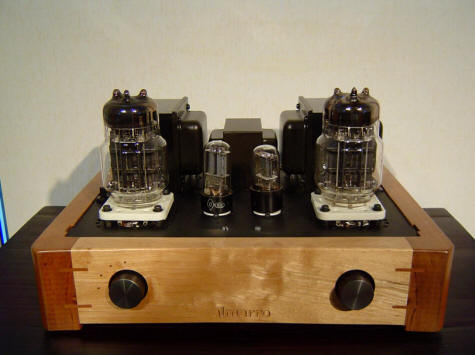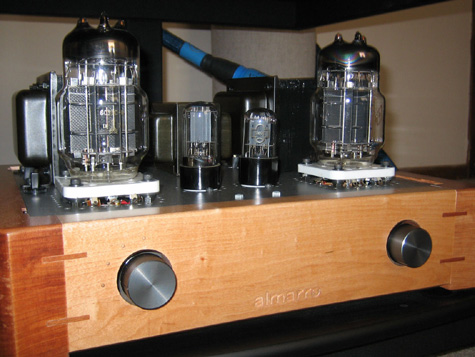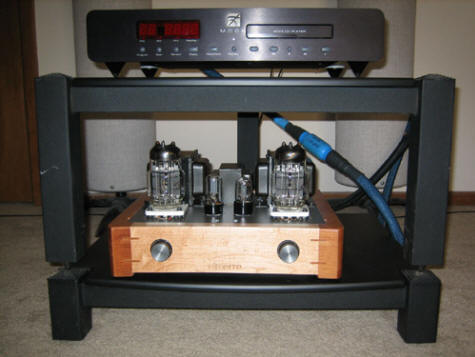
You are reading the older HTML site
Positive Feedback
ISSUE
24
almarro
A318B integrated amplifier
as reviewed by John Acton

|
JOHN ACTON'S SYSTEM
LOUDSPEAKERS
ELECTRONICS
SOURCES
CABLES
ACCESSORIES
|
Single-ended triode amplifiers have attracted a devoted following for decades. Typically low in power and finicky about matching speaker impedances, SETs have nonetheless been the amplifiers of choice for many audiophiles, who refuse to live without their harmonic richness, burnished glow, and musical rightness. Higher-powered SETs exist, but they are expensive, so for most audiophiles, enjoying music via a SET amp means using high-efficiency loudspeakers. However, what if you could have your cake and eat it too? What if you could have the musicality of an SET amp along with enough power and current delivery to drive a wide range of speakers? And what if you could do it all at a reasonable price? Impossible, you say? Say hello to Almarro's A318B SET integrated amp ($1850).
Almarro (www.almarro.com) is a Japanese manufacturer of tube amplifiers and loudspeakers under the direction of owner and chief designer Yoshihiro Muramatsu. The A318B replaces the A318A in the Almarro lineup, and while the two amps are superficially identical, the A318B represents a significant departure from its predecessor. According to Muramatsu, reviewers and owners complained about the A318A's less-than-stellar bass control and its lack of high-end extension. The A318B represents Muramatsu's efforts to address those issues while retaining the midrange musicality for which the A318A was praised.
The A318B is extraordinarily well built. Though compact, measuring just 14 by 7.2 by 13.2 inches, it weighs a hefty 43 pounds. It is finished on all sides in solid wood. The side panels on my review sample were oak, and the amp looked very attractive. The front panel has two knobs, one for adjusting volume and the other for selecting the source, plus an understated, tasteful engraving of the company name. The back panel has three high-quality single-ended inputs for line-level sources, two substantial five-way binding posts with 8-ohm and 4-ohm taps, and an IEC receptacle for the power cord. The power switch and the pots for adjusting bias are on the top panel. A remote control is not included, and neither is a built-in bias meter. Muramatsu has clearly focused his attention on sound.
The A318B's tube complement includes 6SL7 and 6SN7 input and driver tubes and one formidable-looking 6C33C output tube for each channel. All tubes are NOS. The A318B differs from the A318A by incorporating much larger output transformers for better bass control and power delivery, and a modest (5.4dB) amount of global feedback for more extension at the frequency extremes. The A318B is rated at a similar 18 watts per channel, but it will deliver 50 percent more power at 50Hz than the A318A, with extension to 30kHz.

The A318B arrived well packed, with the tubes in their own bubble-wrapped enclosure. Also in the box were a nondescript power cord and a comprehensive manual. While it provides detailed instructions for all aspects of the amplifier's operation, the manual pays special attention to installing and biasing the tubes and includes full-color photographs—a nice touch.
Installing the tubes was a snap, and the amp was up and running within minutes. Upon powering up, the A318B engages a relay-controlled timer to allow the tubes time to warm up and stabilize. After two minutes, the relay clicks and the amp is ready for business. It is important to note that the 6C33C output tubes are extremely subject to bias drift during the first 100 hours or so. During this period, the bias must be checked every hour and adjusted if necessary. The 6C33Cs operate at an optimal bias of .2 volts, and if they are allowed to drift much above .22 volts, their lifespan will be considerably shortened.
The A318B generates a lot of heat and requires plenty of ventilation. I found that it needed to be on for about thirty minutes before it sounded its best. The amp is extremely quiet. With the volume at zero, I had to put my ear up to the tweeters to hear any noise. I did note something peculiar, however. As the volume was increased, the noise increased slightly, but then decreased as the volume approached maximum. I've never heard an amp do that. When I informed Muramatsu, he thought it might be due to a bad tube, and immediately sent out a new batch. The new tubes did not solve the anomaly, but I never found it to be an issue, as the A318B was one of the quietest tube amps I've heard. The noise was never discernible beyond about a foot or so from the speakers.

When I first listened critically to the A318B, I was bowled over by its seemingly paradoxical juxtaposition of nuanced musicality and sheer power. No matter what speakers I used (none of more than medium efficiency), I was treated to marvelously musical sound coupled with a wellspring of power and dynamic snap. King Crimson's latest release, The Power to Believe (Discipline Global Mobile/Sanctuary Records 06076-84585-2), is a complex and dynamic tour de force. Quiet and idyllic at the start, "Dangerous Curves" suddenly transforms into a room-threatening wall of hurricane-force chaos. Not only did the A318B rise to the challenge, it equaled or surpassed every other amp I've had in my system. I couldn't believe I was hearing this kind of performance from an 18-watt amp! There was consummate life and energy, with absolutely no dynamic compression. The icing on the cake was the warmth and natural tone with which the A318B rendered Adrian Belew's vocals. It was truly a beauty-and-the-beast experience.
Aside from its seemingly limitless power reserves, I was taken by the A318B's natural midrange. Warm and supple, without veering toward excess, the A318B did a marvelous job with voices and other midrange instruments. Erlend Oye and Eirik Glambek Boe's voices on "Cayman Islands," from the Kings of Convenience CD, Riot on an Empty Street (Astralwerks ASW 71665), were present, palpable, and extremely natural. There was no etch, glare, or bloat to spoil the illusion that they were singing in the front of my room. The acoustic guitar work was likewise very natural sounding, with plenty of transient snap and decay.
Less-than-reference fare also benefited from the A318B's midrange capabilities. The vocal on "We Were All Uprooted," from Vangelis' Earth CD (Polygram/Vertigo 532 783-2) had more warmth, presence, and verisimilitude than I'm accustomed to hearing. Likewise, Ian Anderson's flute soloing on "My God," from Jethro Tull's Aqualung (Chrysalis 7243-95401-2), had a more natural tone than usual. For the longest time, I couldn't make up my mind whether this effect was an additive coloration, but after spending much time with the A318B I concluded that this little amp simply gets closer to the underlying heart of the midrange, with less electronic obfuscation.
I was similarly impressed with the A318B's treble performance. Neither bright nor rolled off, the treble was extended and airy, with an ineffable sweetness that benefited every recording I played. On well-recorded material like the Bill Frisell CD with Dave Holland and Elvin Jones (nonesuch 79624-2), the attack and decay of the cymbal work was beyond reproach, and the A318B did an excellent job of rendering the slightly shut-in and airless sibilants and cymbal work on the Police's Synchronicity CD (A&M 069 493 599-2) with less edge and grit. The A318B seemed to be at its best in improving these imperfectly mastered digital recordings, to the benefit of a sizable percentage of my music collection.
Coupled with its enormous power swings and extraordinary way with dynamics, the Almarro A318B produced bass that was out of all proportion to its size and power rating. There was a solidity and power to the A318B's portrayal of deep bass that was utterly astonishing. I have never heard the synthesizer and sequencer sounds on "Ants in Me Room" from Radio Massacre International's Solid States CD (Northern Echo NE012) rendered with such power and authority. Likewise, the bass pedal work on "Firth of Fifth" from Genesis' Selling England by the Pound (Atlantic 82675-2) was as powerful and extended as I've ever heard. And the best part was that there was no accompanying overhang or bloat, and no emphasis in the mid or upper bass. Was this effect entirely natural? Perhaps not. Did I care? Not even a bit.
Okay, so the Almarro A318B did many things right. Did it do anything wrong? I did note a couple of shortcomings during the course of my listening. Compared to other amps, both tube and solid state, the A318B showed a slight lack of imaging precision. There was less delineation of individual performers within the soundstage, and the images sometimes overlapped. The A318B was not as resolving as some other amps I've had in my system. If you want to hear way back into the soundstage, and pick up on every subtle detail and ambient nuance, the A318B may not be your first choice. Lastly, the amplifier's gain is very high. I found it difficult to advance the volume control past 9 o'clock without getting blown out of my room, which sometimes made it a challenge to find the right listening level, especially on loudly-mastered recordings.
When I compared the A318B to my reference Audio Zone Amp-1, differences were readily apparent. The Amp-1 was quicker and had better imaging precision. Because it sounded slightly cleaner and more immediate, I could more easily discern the subtle detail cues that were obscured by the A318B. The A318B, on the other hand, surpassed the Amp-1 in its natural portrayal of voices and other midrange instruments. It sounded less electronic. Likewise, the superb treble of the A318B made the Amp-1 sound more mechanical and "transistorized." There was a slight glaze to the Amp-1's treble that was only evident in direct comparison to the A318B. The A318B's bass, while perhaps not as technically accurate as that of the Amp-1, was clearly superior in depth and power. Both amps are excellent, but will appeal to different tastes.
Beautiful in appearance, Almarro's A318B tube integrated amplifier represents a sonic miracle of sorts. Possessing the finely hewn texture and burnished midrange that is the purview of SET designs, the Almarro amp transcends their power and current delivery limitations. By exhibiting dynamic tracking and power delivery reminiscent of a push-pull design, the A318B allows its owner to choose from a much wider range of loudspeakers while maintaining the rich midrange reproduction of an SET design. While not the ultimate in focus, precision, or detail retrieval, the A318B speaks more to the heart than to the intellect. It represents the perfect amplifier for listeners who wish to connect emotionally with their favorite music. I thoroughly enjoyed my time with the Almarro A318B, and highly recommend it to anyone looking for a reasonably priced SET amplifier, especially if their choice of loudspeaker has precluded the use of an SET design. John Acton
Specifications
-
Tube components: 6C33C x 2, 6SL7 x 1, 6SN8 x 1
-
Output Power: 18W x 2ch, 37W x 1ch
-
3 RCA inputs
-
Output: 4, 8 ohms
-
Frequency response: 10-30KHz
-
Dimension: W14" x H7.2" x D13.2"
-
Weight: 43 lb
A318B integrated amplifier
Retail: $1850
Almarro
web address:
www.almarro.com
